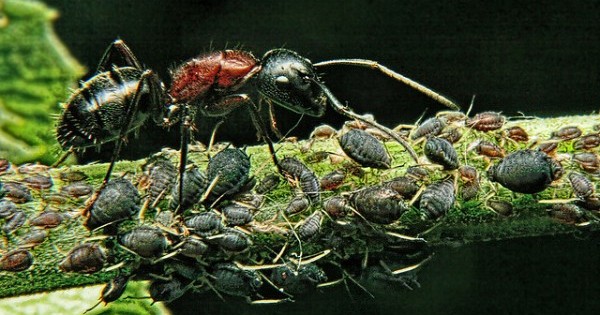
Ants live wherever there is land. They evolved from wasps at least 140 million years ago, and 14,000 or so species are so far identified. They live in colonies with a queen or queens (depending on the species) at the center. The queen lays eggs. The worker ants—sterile daughters—do everything else. Ant colonies can be small, with 100 ants in residence, or large, with millions in residence. Wherever you are (except in Antarctica), you are likely to be mere yards from an ant colony. Right now, outside my house, pavement ants (Tetramorium caespitum) are busy making little piles of sand in the pavement cracks.
Many ant species evolved with plants, notes myrmecologist Deborah M. Gordon in Ant Encounters. Ant-plant relationships are common in the tropics. A colony might live in its plant and kill competing plants in the neighborhood by injecting formic acid into the competition’s vascular system. Another ant species might feed on herbaceous insects intending to dine on the ant plant. Still another species farms leaf-sucking scale insects. The scales feed on the plant, and the ants “milk” the scales for sugary stuff scales excrete called honeydew. The ants defend the plant against its enemies, and the community thrives.
If you were an ant, you would perceive the world mainly through chemical signals emitted by glands. (Ants also see, although not well, and they sense vibrations.) Ants, write myrmecologists Bert Hölldobler and E. O. Wilson in their luscious and erudite book The Superorganism, are “the insect geniuses of chemical communication.” Ant species taken together have 40 different exocrine glands, most for producing pheromones, chemical signals both odiferous and meaningful.
In her book, Gordon focuses on the social lives of the red harvester ants of the Southwest, Pogonomyrmex barbatus, seed eaters. She notes that (no matter what the species) the queen is not the boss, since ant colonies have no boss. No ant is doing what it is told. The workers carry out tasks. (But many ants in a given colony are sitting around doing nothing.) Tasks include feeding and grooming the queen, feeding the larvae, moving pupae (from which adult ants emerge), guard duty, garbage duty, foraging duty, processing and distributing food, and building and maintaining the nest. Tasks outside the nest are performed by patrollers, nest maintenance workers, midden workers (the sanitation department), and foragers.
Gordon’s studies show that ants are not genetically programmed to carry out a task. Red harvester ants switch tasks (within some limits) depending on what needs to be done. (If you remove all the forager ants, other ants accustomed to other tasks will take up foraging.) Her findings (“I’ve probably watched more ant colonies for longer than any other scientist…”) contradict earlier notions of ants being genetically wired to carry out tasks, rather like an ideal (for the capitalist) Ford Motor Co. assembly line.
First thing in the morning the patrollers emerge. They establish an “all clear” and set the day’s direction for the search for food. Foragers decline to emerge until patrollers return. Ants touch one another, giving and receiving information with their antennae. This contact, or encounter, stimulates them to action. One patroller returning is not enough to stimulate a forager to go out and forage. It takes several encounters and if, after the first encounter, 10 seconds pass before the next one, the first doesn’t count because the ant forgets it.
So an ant colony functions as a networking system, with many points of contact, and with contacts lighting up and fading away. (No, the Internet isn’t being run by ants.)
In some ways individual ants act like cells in a single body (the superorganism idea), but in other ways individual ants differ from one another. Some ants move around a lot more than others, and because ants communicate by contact and by spreading odors those that move around more cause more action. Some ants work harder than others, but when you remove the hard workers, the lazy ants start working harder. An ant colony exhibits an alarming amount of random motion and aimless inefficiency (and they’re not even trying to write poems). But the colony succeeds.
Right now I go out to the street with a ballpoint pen and a magnifying glass. I stir the little sand pile and watch ants run in circles as if they’re having hysterics. They are, I suppose, spreading the alarm pheromone. But what, exactly, are they planning to do about it?

